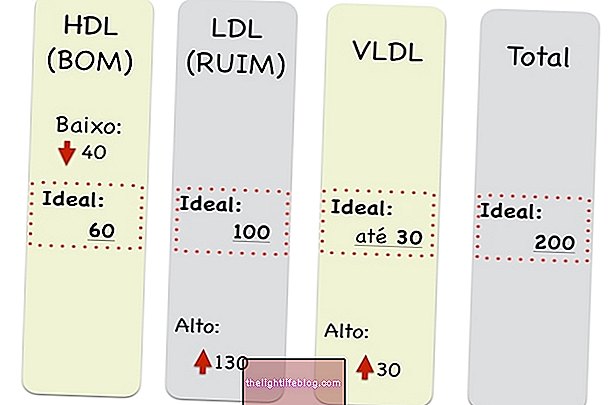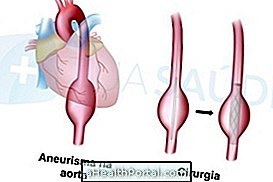Total cholesterol should always be below 190 mg / dL. Having high total cholesterol does not always mean that the person is ill as it can occur by a good cholesterol increase (HDL), which also raises the total cholesterol values. Therefore, you should always take into account the values of HDL (good), LDL (bad) cholesterol and triglycerides to analyze a person's risk of developing cardiovascular diseases.
The symptoms of high cholesterol only manifest themselves when their values are very high. Therefore, after the age of 20 years it is recommended to perform blood tests for cholesterol at least every 5 years in healthy individuals and more regularly, at least once a year, by those who already have the diagnosis of high cholesterol, who has diabetes or who is pregnant, for example. Reference values for blood cholesterol control vary according to age and health status.

1. Table of reference values for cholesterol
Check the table below for the desired cholesterol reference values, according to age, by the Brazilian cardiology society:
| Type of cholesterol | Reference value for adults over 20 years of age | Reference value for children and adolescents |
| Total cholesterol | less than 190 mg / dl | less than 170 mg / dl |
| HDL cholesterol (good) | greater than 40 mg / dl | greater than 45 mg / dl |
| LDL (bad) cholesterol |
less than 130 mg / dl - in people with low cardiovascular risk * less than 100 mg / dl - in people with intermediate cardiovascular risk * less than 70 mg / dl - in people with high cardiovascular risk * less than 50 mg / dl - in people with very high cardiovascular risk * | less than 110 mg / dl |
Non-HDL Cholesterol (sum of LDL, VLDL and IDL) | less than 160 mg / dl - in people with low cardiovascular risk * less than 130 mg / dl - in people with intermediate cardiovascular risk * less than 100 mg / dl - in people with high cardiovascular risk * less than 80 mg / dl - in people with very high cardiovascular risk * | --- |
* Cardiovascular risk is calculated by the physician during the consultation, and takes into account the person's risk factors for developing cardiovascular disease, such as old age, smoking, presence of high blood pressure, diabetes, kidney disease or other heart disease, for example .
Triglycerides are another type of fat in the body, used as a reserve of energy by the body, and when they are high also increase the risk of deposits of atherosclerosis in blood vessels and increase the risk of cardiovascular disease.
2. Table of reference values for triglycerides
The table of normal values of triglycerides, by age, recommended by the Brazilian society of cardiology are:
| Triglycerides | Adults over 20 years | Children (0-9 years) | Children and adolescents (10-19 years) |
| In fasting | less than 150 mg / dl | less than 75 mg / dl | less than 90 mg / dl |
| Not fasting | less than 175 mg / dl | less than 85 mg / dl | less than 100 mg / dl |
If you have high cholesterol see what you can do to download these values in the following video:

Why It Is Important To Control Cholesterol Rates
The normal values of cholesterol should be maintained because it is important for the health of cells and for the production of hormones in the body. About 70% of the cholesterol present in the body is produced by the liver and the rest comes from food, and only when the body has more cholesterol than it needs to, it is deposited inside the arteries, decreasing blood flow and favoring the appearance of cardiac problems. Understand better what are the causes and consequences of high cholesterol.
See what your laughter of having heart problems:

Cholesterol values in pregnancy
During pregnancy the cholesterol reference values are not yet established, so pregnant women should be based on the reference values of healthy adults, but always with medical follow-up. During gestation, cholesterol values are usually high, especially in the second and third semesters. Women who have gestational diabetes should be given extra attention because their cholesterol levels tend to rise even more. Here's how to lower high cholesterol in pregnancy.





















